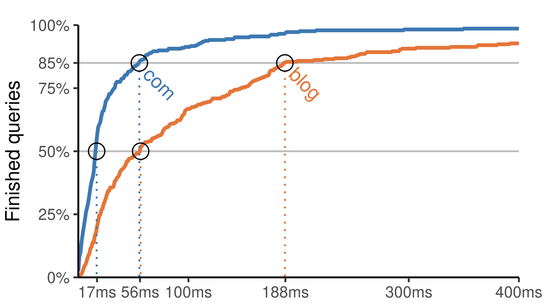BunnyCDN shared some interesting performance benchmarks of the name servers responsible for some generic top-level domains (gTLD). The Content Delivery Network (CDN) provider measured Domain Name System (DNS) response times from 50 locations around the world.
I’m using a .blog domain for this website. Unfortunately, this gTLD is placed near the bottom of the list. Ouch. There’s nothing I can do to improve the situation other than to complain publicly. So, here I go!
I recreated a smaller version of their experiment for the .blog and .com gTLDs. I don’t have a content distribution (CDN) network with 50 points of presences around the globe to test from.
However, I do have a RIPE Atlas test probe. It enables me to run a quick test like this from 11 000 locations around the world. I settled for recreating BunnyCDN’s tests from 300 locations, however. You can see the results from my test in the footer and the graph at the top of this article.
The median resolution time for .com is 17 milliseconds versus 57 ms for .blog. That means .blog is 2,3 times slower. The .com gTLD responded to 85 % of all queries in 55 ms compared to 188 ms for .blog. That makes .blog 2,4 times slower.
BunnyCDN benchmark and my benchmark compared
| .com | .blog | |||
|---|---|---|---|---|
| 50 % | 85 % | 50 % | 85 % | |
| BunnyCDN | 41 ms | 91 ms | 122 ms | 176 ms |
| My figures | 17 ms | 57 ms | 55 ms | 188 ms |
Both sets of figures are a snapshot in time from different locations under different local and global network conditions. They’re expected to be a bit different. The take-away is clear: the .com gTLD is 2–3 times faster than the .blog gTLD.
So, what’s going on with .blog?
The .blog gTLD is owned by Knock Knock WHOIS There LLC; a subsidiary of Automattic Inc. This is interesting because WordPress.com, another Automattic subsidiary, operates the second-fastest authoritative name servers in the world, according to DNSPerf by PerfOps.
However, the .blog gTLD doesn’t share backend infrastructure with WordPress.com. Instead, it’s outsourced to a gTLD management service company called CentralNic Group PLC. You’ve probably never heard of the company before. However, you might recognize some of the other gTLDs it operates: .best, .design, and .xyz.
If you don’t recognize these gTLDs, then go and have another look at the bottom of the list in BunnyCND’s benchmarks. You’ll find all of them near the bottom. It would seem that this service provider doesn’t focus on performance.
Do these tiny numbers even mean anything?
Google requires a webpage to load in 1 second or less to receive a “fast” rating. This performance rating directly impacts a website’s ranking in the company’s search result pages.
Your TLD’s name servers are completely outside of your control. They still impact your site’s performance, however. To put the numbers in context, the .blog gTLD’s 122 ms median time is 12,2 % of the total page-load time budget.
In retrospect, maybe I should have kept using my old .com domain instead of switching to .blog. I strongly prefer the new .blog domain, but these performance metrics are worrying.
Conclusions
If you have a domain zone configured for long-lived DNS caching and a high volume of lookups, you don’t need to worry about this issue. Anyone falling outside this category should stop worrying too: There’s nothing you can do about it other than migrating to a different TLD.
You may want to avoid registering any new domains under TLDs operated by CentralNic, however. As I said above, it don’t seem to focus on performance. Or, maybe it simply doesn’t operate on a scale that allows it to deliver it.
As a .blog domain registrant, I can only hope that Knock Knock WHOIS There will switch to use the same infrastructure as WordPress.com.
